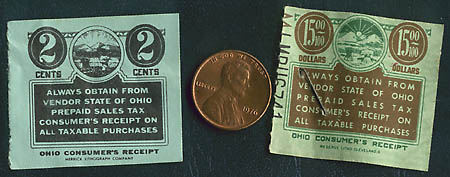|
Mark Schweickart
Jocko,
Is that mysterious "device" that doesn't allow you to type a response of more than a sentence or two, perhaps your "fingers"? You may need to get that checked out, my friend.
Dave F.
I have to admit, although I certainly remember the embarrasment of going door to door trying to sell Turkey Raffle tickets, I drew a complete blank on your reference to collecting sales tax stamps. I looked on line and found this explanation of how that worked from a personal website done by a guy our age who grew up in Richwood, Ohio (a little northwest of Delaware). His name is Thomas Thomas, or T-Squared as his friends call him. Here's his explanation of Ohio sales tax stamps (I'm surprised I don't remember any of this):
Do these sales tax receipts look familiar? Older folks who grew up in Ohio, such as myself, may remember them. These little pieces of paper, about an inch and a half square (compare their size to the penny), were called sales tax "stamps," even though they had no adhesive on the back.

Ohio enacted its first sales tax in 1935. The rate was 3%, with two-thirds of the money to go to schools.
Naturally, there was some resistance to the new tax. Merchants were reluctant to charge it, and customers were reluctant to pay it. There was a real possibility that a merchant would do his customer a favor by letting him make his purchase tax-free. If the merchant never reported the sale to the state, the state would never know that it should have gotten its 3%.
To encourage compliance, these stamps were introduced. Merchants were required to buy them in various denominations from the state. The state would thus get its money up front, and the merchant would get a few boxes of stamps imprinted "Prepaid Sales Tax."
Then suppose a customer made a 68¢ purchase and gave the merchant a dollar bill. The tax would be 2¢, according to the printed charts that were posted near every cash register, so the total would be 70¢. The merchant would tear off a 2¢ stamp like the one shown here and give the customer his change: a quarter, a nickel, and the stamp.
If the merchant handed out stamps as he was supposed to, eventually he would run low and have to buy another block of them from the state, so the tax revenue would keep flowing.
The customer had to do his part by demanding his stamps. They were marked, "Always obtain from vendor . . . consumer's receipt on all taxable purchases." But why should the customer care whether the merchant was buying and distributing stamps? These little pieces of paper were just a nuisance.
To handle that problem, the state encouraged consumers to collect the stamps and give them to schools or charities. These organizations could then have their volunteers sort the stamps, count them, bundle them up, turn them in to the state, and collect three per cent of the face value. This added a little to the expense of collecting the tax, but it was worth it.
My father's business didn't sell many 68¢ items. He owned an automobile dealership, selling vehicles that might cost as much as $3,000 for a fancy new Oldsmobile. The tax on $3,000 would be $90, so my father had to buy large-denomination tax stamps like the $15 one above and staple six of them to the invoice for that new Olds. The donation of a stamp like this would be greatly appreciated by a charity's fund drive, which could redeem a $15 stamp to receive a full 45 cents.
However, once the consumers had been trained to pay the tax, the state discontinued the stamp program in 1962. Five years later, the sales tax rate went up to 4%. Ohioans grumbled, but they paid.
|